Modelling the Dynamics of Carbon Storages for Pinus densata Using Landsat Images in Shangri-La Considering Topographic Factors
Abstract
1. Introduction
2. Materials and Methods
2.1. Study Area and Study Process
2.2. Ground Survey Data and Carbon Storage Calculation
2.3. Remote Sensing Images and Obtained Features
2.3.1. Remote Sensing Data
2.3.2. Remote Sensing Features
2.4. Terrain Niche Index
2.5. Distribution Index
2.6. Modelling Process
2.6.1. Calculation of Change Data
2.6.2. Remote Sensing Features Selection
2.6.3. Modelling Methods
2.7. Accuracy Evaluation
3. Results
3.1. Analysis of Modelling Results
3.2. Mapping Carbon Storage
3.3. Spatial Distribution Characteristics for the Changes in Carbon Storage on Different TNI Gradients
4. Discussion
5. Conclusions
Author Contributions
Funding
Data Availability Statement
Acknowledgments
Conflicts of Interest
References
- Shao, W.; Cai, J.; Wu, H.; Liu, J.; Zhang, H.; Huang, H. An Assessment of Carbon Storage in China’s Arboreal Forests. Forests 2017, 8, 110. [Google Scholar] [CrossRef]
- Solomon, S.D.; Qin, D.; Manning, M.; Chen, Z.; Miller, H.L. Climate Change 2007: The Physical Science Basis. In Working Group I Contribution to the Fourth Assessment Report of the IPCC; Cambridge University Press: Cambridge, UK, 2007. [Google Scholar]
- Luo, K. Spatial Pattern of Forest Carbon Storage in the Vertical and Horizontal Directions Based on HJ-CCD Remote Sensing Imagery. Remote Sens. 2019, 11, 788. [Google Scholar] [CrossRef]
- Li, T.; Li, M.-Y.; Tian, L. Dynamics of Carbon Storage and Its Drivers in Guangdong Province from 1979 to 2012. Forests 2021, 12, 1482. [Google Scholar] [CrossRef]
- Long, Y.; Jiang, F.G.; Sun, H.; Wang, T.H.; Zou, Q.; Chen, C.S. Estimating vegetation carbon storage based on optimal bandwidth selected from geographically weighted regression model in Shenzhen City. Acta Ecol. Sin. 2022, 42, 4933–4945. [Google Scholar]
- Zhang, P.P.; Li, Y.H.; Yin, H.R.; Chen, Q.T.; Dong, Q.D.; Zhu, L.Q. Spatio-temporal variation and dynamic simulation of ecosystem carbon storage in the north-south transitional zone of China. J. Nat. Resour. 2022, 37, 1183–1197. [Google Scholar] [CrossRef]
- Yan, E.; Lin, H.; Wang, G.; Sun, H. Improvement of Forest Carbon Estimation by Integration of Regression Modeling and Spectral Unmixing of Landsat Data. IEEE Geosci. Remote Sens. Lett. 2015, 12, 2003–2007. [Google Scholar]
- Safari, A.; Sohrabi, H.; Powell, S.; Shataee, S. A comparative assessment of multi-temporal Landsat 8 and machine learning algorithms for estimating aboveground carbon stock in coppice oak forests. Int. J. Remote Sens. 2017, 38, 6407–6432. [Google Scholar] [CrossRef]
- Sun, W.; Liu, X. Review on carbon storage estimation of forest ecosystem and applications in China. For. Ecosyst. 2019, 7, 4. [Google Scholar] [CrossRef]
- Gómez, C.; White, J.C.; Wulder, M.A. Characterizing the state and processes of change in a dynamic forest environment using hierarchical spatio-temporal segmentation. Remote Sens. Environ. 2011, 115, 1665–1679. [Google Scholar] [CrossRef]
- Gómez, C.; White, J.C.; Wulder, M.A.; Alejandro, P. Historical forest biomass dynamics modelled with Landsat spectral trajectories. ISPRS J. Photogramm. Remote Sens. 2014, 93, 14–28. [Google Scholar] [CrossRef]
- Zhang, J.; Lu, C.; Xu, H.; Wang, G. Estimating aboveground biomass of Pinus densata-dominated forests using Landsat time series and permanent sample plot data. J. For. Res. 2019, 30, 1689–1706. [Google Scholar] [CrossRef]
- Liu, C.; Zhang, L.; Li, F.; Jin, X. Spatial modeling of the carbon stock of forest trees in Heilongjiang Province, China. J. For. Res. 2014, 25, 269–280. [Google Scholar] [CrossRef]
- Oltean, G.S.; Comeau, P.G.; White, B. Linking the Depth-to-Water Topographic Index to Soil Moisture on Boreal Forest Sites in Alberta. For. Sci. 2016, 62, 154–165. [Google Scholar] [CrossRef]
- Deng, Y.; Chen, X.; Kheir, R.B. An Exploratory Procedure Defining a Local Topographic Index for Mountainous Vegetation Conditions. GIScience Remote Sens. 2007, 44, 383–401. [Google Scholar] [CrossRef]
- Wu, A.B.; Qin, Y.J.; Zhao, Y.X. Terrain composite index and its application in terrain gradient effect analysis of land use change: A case study of Taihang Hilly areas. Geogr. Geo. Inf. Sci. 2018, 34, 93–99+118. [Google Scholar]
- Wang, Q.; Yang, K.; Li, L.; Zhu, Y. Assessing the Terrain Gradient Effect of Landscape Ecological Risk in the Dianchi Lake Basin of China Using Geo-Information Tupu Method. Int. J. Environ. Res. Public Health 2022, 19, 9634. [Google Scholar] [CrossRef] [PubMed]
- Gong, W.; Wang, H.; Wang, X.; Fan, W.; Stott, P. Effect of terrain on landscape patterns and ecological effects by a gradient-based RS and GIS analysis. J. For. Res. 2017, 28, 1061–1072. [Google Scholar] [CrossRef]
- Zhao, Y.; Cao, J.; Zhang, X.; Zhang, M. Analyzing the characteristics of land use distribution in typical village transects at Chinese Loess Plateau based on topographical factors. Open Geosci. 2022, 14, 429–442. [Google Scholar] [CrossRef]
- Li, C.; Chen, D.; Wu, D.; Su, X. Design of an EIoT system for nature reserves: A case study in Shangri-La County, Yunnan Province, China. Int. J. Sustain. Dev. World Ecol. 2015, 22, 184–188. [Google Scholar] [CrossRef]
- Pan, J.; Wang, J.; Gao, F.; Liu, G. Quantitative estimation and influencing factors of ecosystem soil conservation in Shangri-La, China. Geocarto Int. 2022, 1–15. [Google Scholar] [CrossRef]
- Yu, Y.; Wang, J.; Liu, G.; Cheng, F. Forest Leaf Area Index Inversion Based on Landsat OLI Data in the Shangri-La City. J. Indian Soc. Remote Sens. 2019, 47, 967–976. [Google Scholar] [CrossRef]
- Chen, Y.; Wang, J.; Liu, G.; Yang, Y.; Liu, Z.; Deng, H. Hyperspectral Estimation Model of Forest Soil Organic Matter in Northwest Yunnan Province, China. Forests 2019, 10, 217. [Google Scholar] [CrossRef]
- Sun, X.L. Study on Biomass Estimation of Pinus Densata in Shangri-La Based on Landsat8-OLI. Master’s Thesis, Southwest Forestry University, Kunming, China, 2016. [Google Scholar]
- Yao, X.L.; Chen, H.L.; Zhao, X.; Guo, S.J. Weak link determination of anti-shock performance of shipboard equipments based on Pauta criterion. Chin. J. Ship Res. 2007, 2, 10–14. [Google Scholar]
- Xie, H.; Zhao, A.; Huang, S.; Han, J.; Liu, S.; Xu, X.; Luo, X.; Pan, H.; Du, Q.; Tong, X. Unsupervised Hyperspectral Remote Sensing Image Clustering Based on Adaptive Density. IEEE Geosci. Remote Sens. Lett. 2018, 15, 632–636. [Google Scholar] [CrossRef]
- LY/T 2988-2018; Guideline on Carbon Stock Accounting in Forest Ecosystem. State Forestry and Grassland Administration of China: Beijing, China, 2018; pp. 1–16.
- Chander, G.; Markham, B.L.; Helder, D.L. Summary of current radiometric calibration coefficients for Landsat MSS, TM, ETM+, and EO-1 ALI sensors. Remote Sens. Environ. 2009, 113, 893–903. [Google Scholar] [CrossRef]
- Yu, K.; Liu, S.; Zhao, Y. CPBAC: A quick atmospheric correction method using the topographic information. Remote Sens. Environ. 2016, 186, 262–274. [Google Scholar] [CrossRef]
- Nichol, J.; Hang, L.K.; Sing, W.M. Empirical correction of low Sun angle images in steeply sloping terrain: A slope-matching technique. Int. J. Remote Sens. 2006, 27, 629–635. [Google Scholar] [CrossRef]
- Zhang, J.; Pham, T.-T.-H.; Kalacska, M.; Turner, S. Using Landsat Thematic Mapper records to map land cover change and the impacts of reforestation programmes in the borderlands of southeast Yunnan, China: 1990–2010. Int. J. Appl. Earth Obs. Geoinf. 2014, 31, 25–36. [Google Scholar] [CrossRef]
- Carleer, A.P.; Wolff, E. Urban land cover multi-level region-based classification of VHR data by selecting relevant features. Int. J. Remote Sens. 2008, 27, 1035–1051. [Google Scholar] [CrossRef]
- Wang, W.; Jiang, Y.; Wang, G.; Guo, F.; Li, Z.; Liu, B. Multi-Scale LBP Texture Feature Learning Network for Remote Sensing Interpretation of Land Desertification. Remote Sens. 2022, 14, 3486. [Google Scholar] [CrossRef]
- Zhang, C.; Huang, C.; Li, H.; Liu, Q.; Li, J.; Bridhikitti, A.; Liu, G. Effect of Textural Features in Remote Sensed Data on Rubber Plantation Extraction at Different Levels of Spatial Resolution. Forests 2020, 11, 399. [Google Scholar] [CrossRef]
- Yuan, J.; Wang, D.; Li, R. Remote Sensing Image Segmentation by Combining Spectral and Texture Features. IEEE Trans. Geosci. Remote Sens. 2014, 52, 16–24. [Google Scholar] [CrossRef]
- Duan, M.; Song, X.; Liu, X.; Cui, D.; Zhang, X. Mapping the soil types combining multi-temporal remote sensing data with texture features. Comput. Electron. Agric. 2022, 200, 107230. [Google Scholar] [CrossRef]
- Rui, B.; Zhang, J.; Lu, C.; Chen, P. Estimating above-ground biomass of Pinus densata Mast. Using best slope temporal segmentation and Landsat time series. J. Appl. Remote Sens. 2021, 15, 024507. [Google Scholar]
- Powell, S.L.; Cohen, W.B.; Healey, S.P.; Kennedy, R.E.; Moisen, G.G.; Pierce, K.B.; Ohmann, J.L. Quantification of live aboveground forest biomass dynamics with Landsat time-series and field inventory data: A comparison of empirical modeling approaches. Remote Sens. Environ. 2010, 114, 1053–1068. [Google Scholar] [CrossRef]
- Wei, H.L.; Qi, Y.J. Analysis of grassland degradation of the Tibet Plateau and human driving forces based on remote sensing. Pratacultural Sci. 2016, 33, 2576–2586. [Google Scholar]
- Zhang, G.L. Spatial distribution characteristics of carbon storage of urban forests in Shanghai based on remote sensing estimation. Ecol. Environ. Sci. 2021, 30, 1777–1786. [Google Scholar]
- Yu, H.; Zeng, H.; Jiang, Z.Y. Study on Distribution Characteristics of Landscape Elements along the Terrain Gradient. Scientia Geogr. Sin. 2001, 1, 64–69. [Google Scholar]
- Emamian, A.; Rashki, A.; Kaskaoutis, D.G.; Gholami, A.; Opp, C.; Middleton, N. Assessing vegetation restoration potential under different land uses and climatic classes in northeast Iran. Ecol. Indic. 2021, 122, 107325. [Google Scholar] [CrossRef]
- Chen, L.D.; Yang, S.; Feng, X.M. Land use change characteristics along the terrain gradient and the spatial expanding analysis: A case study of Haidian District and Yanqing County, Beijing. Geogr. Res. 2008, 27, 1225–1234+1481. [Google Scholar]
- Huang, C.; Goward, S.N.; Schleeweis, K.; Thomas, N.; Masek, J.G.; Zhu, Z. Dynamics of national forests assessed using the Landsat record: Case studies in eastern United States. Remote Sens. Environ. 2009, 113, 1430–1442. [Google Scholar] [CrossRef]
- Lunetta, R.S.; Johnson, D.M.; Lyon, J.G.; Crotwell, J. Impacts of imagery temporal frequency on land-cover change detection monitoring. Remote Sens. Environ. 2004, 89, 444–454. [Google Scholar] [CrossRef]
- Yin, S.-L.; Zhang, X.-L.; Liu, S. Intrusion detection for capsule networks based on dual routing mechanism. Comput. Netw. 2021, 197, 108328. [Google Scholar] [CrossRef]
- Lian, Y.; Luo, J.; Xue, W.; Zuo, G.; Zhang, S. Cause-driven Streamflow Forecasting Framework Based on Linear Correlation Reconstruction and Long Short-term Memory. Water Resour. Manag. 2022, 36, 1661–1678. [Google Scholar] [CrossRef]
- Gregorutti, B.; Michel, B.; Saint-Pierre, P. Correlation and variable importance in random forests. Stat. Comput. 2017, 27, 659–678. [Google Scholar] [CrossRef]
- Zuur, A.F.; Ieno, E.N.; Elphick, C.S. A protocol for data exploration to avoid common statistical problems. Methods Ecol. Evol. 2010, 1, 3–14. [Google Scholar] [CrossRef]
- Farifteh, J.; Van der Meer, F.; Atzberger, C.; Carranza, E.J.M. Quantitative analysis of salt-affected soil reflectance spectra: A comparison of two adaptive methods (PLSR and ANN). Remote Sens. Environ. 2007, 110, 59–78. [Google Scholar] [CrossRef]
- Paul, G.; Kowalski, B.R. Partial least-squares regression: A tutorial. Anal. Chim. Acta 1986, 185, 1–17. [Google Scholar]
- Wold, S.; Sjöström, M.; Eriksson, L. PLS-regression: A basic tool of chemometrics. Chemom. Intell. Lab. Syst. 2001, 58, 109–130. [Google Scholar] [CrossRef]
- Song, G.Y. Research on Partial Least Squares Regression. Master’s Thesis, Zhejiang University, Hangzhou, China, 2009. [Google Scholar]
- Ryan, T.A., Jr.; Joiner, B.L. Minitab: A Statistical Computing System for Students and Researchers. Am. Stat. 1973, 27, 222–225. [Google Scholar] [CrossRef]
- Friedman, J.H. Greedy Function Approximation: A Gradient Boosting Machine. Ann. Stat. 2001, 29, 1189–1232. [Google Scholar] [CrossRef]
- Friedman, J.H. Stochastic gradient boosting. Comput. Stat. Data Anal. 2002, 38, 367–378. [Google Scholar] [CrossRef]
- Lawrence, R.; Bunn, A.; Powell, S.; Zambon, M. Classification of remotely sensed imagery using stochastic gradient boosting as a refinement of classification tree analysis. Remote Sens. Environ. 2004, 90, 331–336. [Google Scholar] [CrossRef]
- Wang, L.; Zhang, Y.; Yao, Y.; Xiao, Z.; Shang, K.; Guo, X.; Yang, J.; Xue, S.; Wang, J. GBRT-Based Estimation of Terrestrial Latent Heat Flux in the Haihe River Basin from Satellite and Reanalysis Datasets. Remote Sens. 2021, 13, 1054. [Google Scholar] [CrossRef]
- Breiman, L. Random Forests. Mach. Learn. 2001, 45, 5–32. [Google Scholar] [CrossRef]
- van der Meer, D.; Hoekstra, P.J.; van Donkelaar, M.; Bralten, J.; Oosterlaan, J.; Heslenfeld, D.; Faraone, S.V.; Franke, B.; Buitelaar, J.K.; Hartman, C.A. Predicting attention-deficit/hyperactivity disorder severity from psychosocial stress and stress-response genes: A random forest regression approach. Transl. Psychiatry 2017, 7, e1145. [Google Scholar] [CrossRef]
- Sun, J.; Zhong, G.; Huang, K.; Dong, J. Banzhaf random forests: Cooperative game theory based random forests with consistency. Neural Netw. 2018, 106, 20–29. [Google Scholar] [CrossRef]
- Wang, X.; Liu, T.; Zheng, X.; Peng, H.; Xin, J.; Zhang, B. Short-term prediction of groundwater level using improved random forest regression with a combination of random features. Appl. Water Sci. 2018, 8, 125. [Google Scholar] [CrossRef]
- Xu, D.; Zhang, J.; Bao, R.; Liao, Y.; Han, D.; Liu, Q.; Cheng, T. Temporal and Spatial Variation of Aboveground Biomass of Pinus densata and Its Drivers in Shangri-La, CHINA. Int. J. Environ. Res. Public Health 2021, 19, 400. [Google Scholar] [CrossRef]
- Li, J.; Sun, G.Z.; Xu, Y.L. Application and anomaly detection of Application and anomaly detection of predictive model based on time series predictive model based on time series. Comput. Aided Eng. 2006, 15, 49–54+84. [Google Scholar]
- Ranjan, K.G.; Tripathy, D.S.; Prusty, B.R.; Jena, D. An improved sliding window prediction-based outlier detection and correction for volatile time-series. Int. J. Numer. Model. Electron. Netw. Devices Fields 2021, 34, e2816. [Google Scholar] [CrossRef]
- Goodwin, N.R.; Coops, N.C.; Wulder, M.A.; Gillanders, S.; Schroeder, T.A.; Nelson, T. Estimation of insect infestation dynamics using a temporal sequence of Landsat data. Remote Sens. Environ. 2008, 112, 3680–3689. [Google Scholar] [CrossRef]
- Zhang, M.; Du, H.; Zhou, G.; Li, X.; Mao, F.; Dong, L.; Zheng, J.; Liu, H.; Huang, Z.; He, S. Estimating Forest Aboveground Carbon Storage in Hang-Jia-Hu Using Landsat TM/OLI Data and Random Forest Model. Forests 2019, 10, 1004. [Google Scholar] [CrossRef]
- Zhang, X.; Sun, Y.; Jia, W.; Wang, F.; Guo, H.; Ao, Z. Research on the Temporal and Spatial Distributions of Standing Wood Carbon Storage Based on Remote Sensing Images and Local Models. Forests 2022, 13, 346. [Google Scholar] [CrossRef]
- Pyles, M.V.; Magnago, L.F.S.; Maia, V.A.; Pinho, B.X.; Pitta, G.; de Gasper, A.L.; Vibrans, A.C.; Santos, R.M.D.; van Den Berg, E.; Lima, R.A. Human impacts as the main driver of tropical forest carbon. Sci. Adv. 2022, 8, eabl7968. [Google Scholar] [CrossRef]
- Nguyen, T.H.; Jones, S.D.; Soto-Berelov, M.; Haywood, A.; Hislop, S. Monitoring aboveground forest biomass dynamics over three decades using Landsat time-series and single-date inventory data. Int. J. Appl. Earth Obs. Geoinf. 2020, 84, 101952. [Google Scholar] [CrossRef]
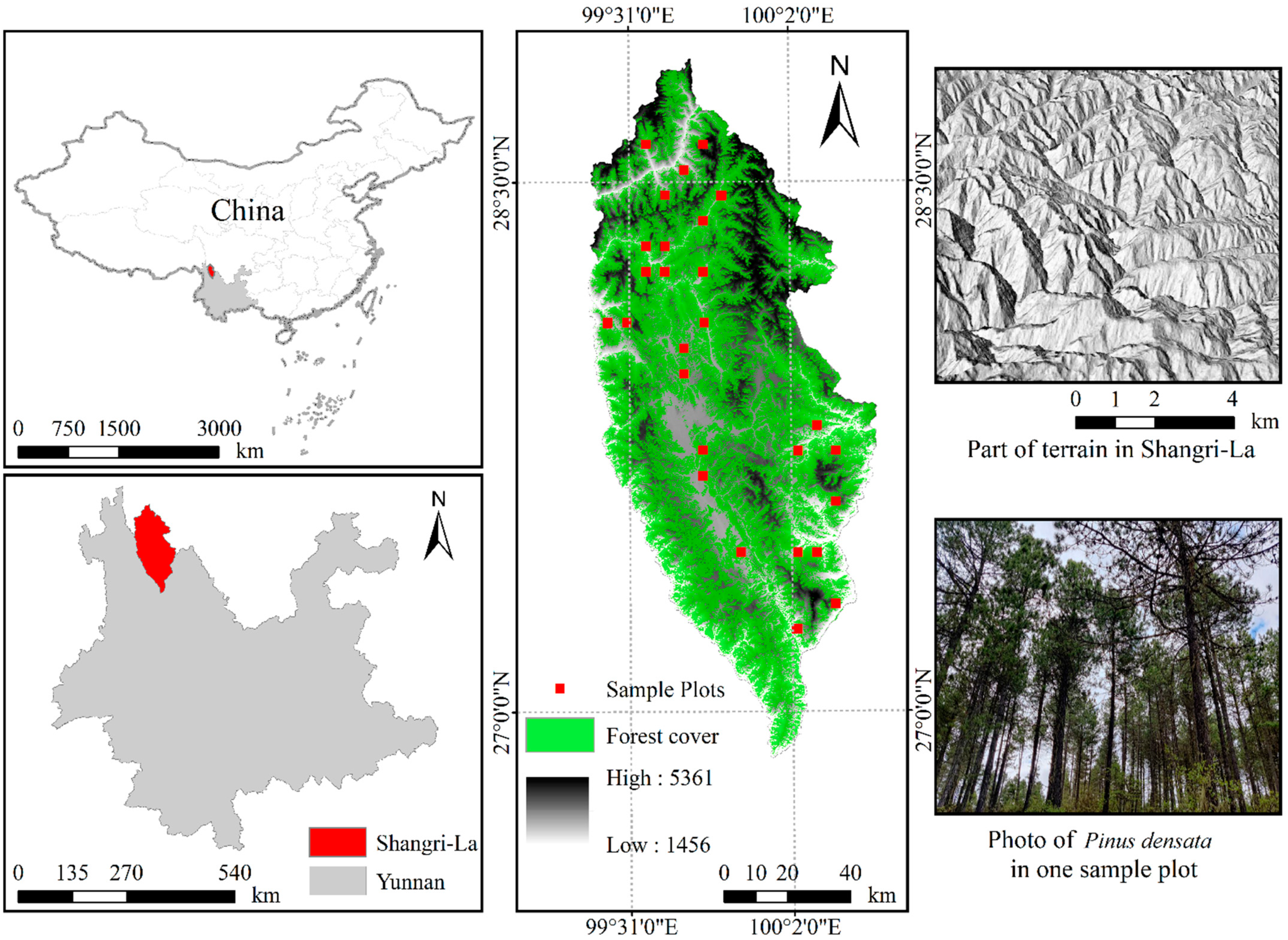
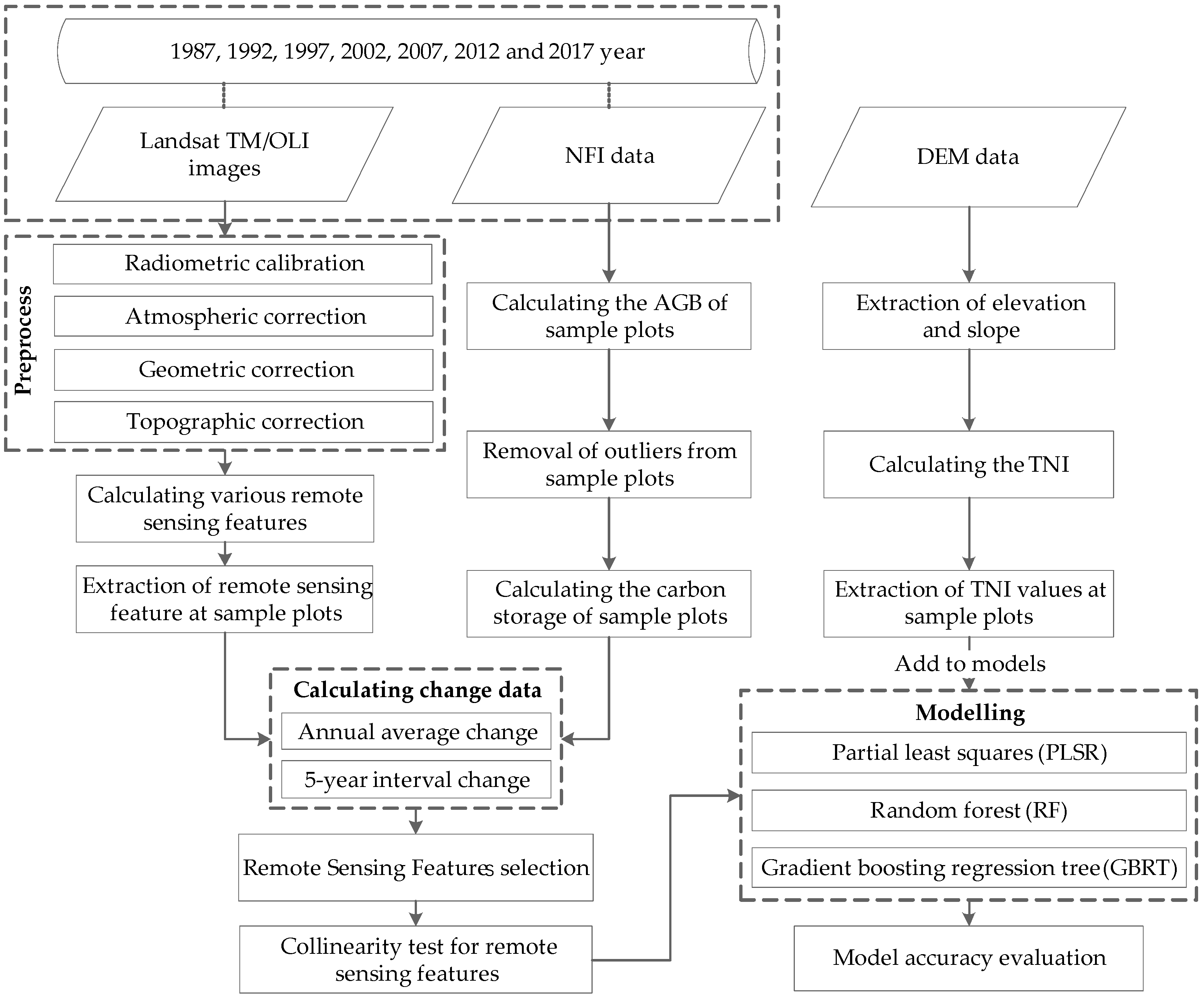
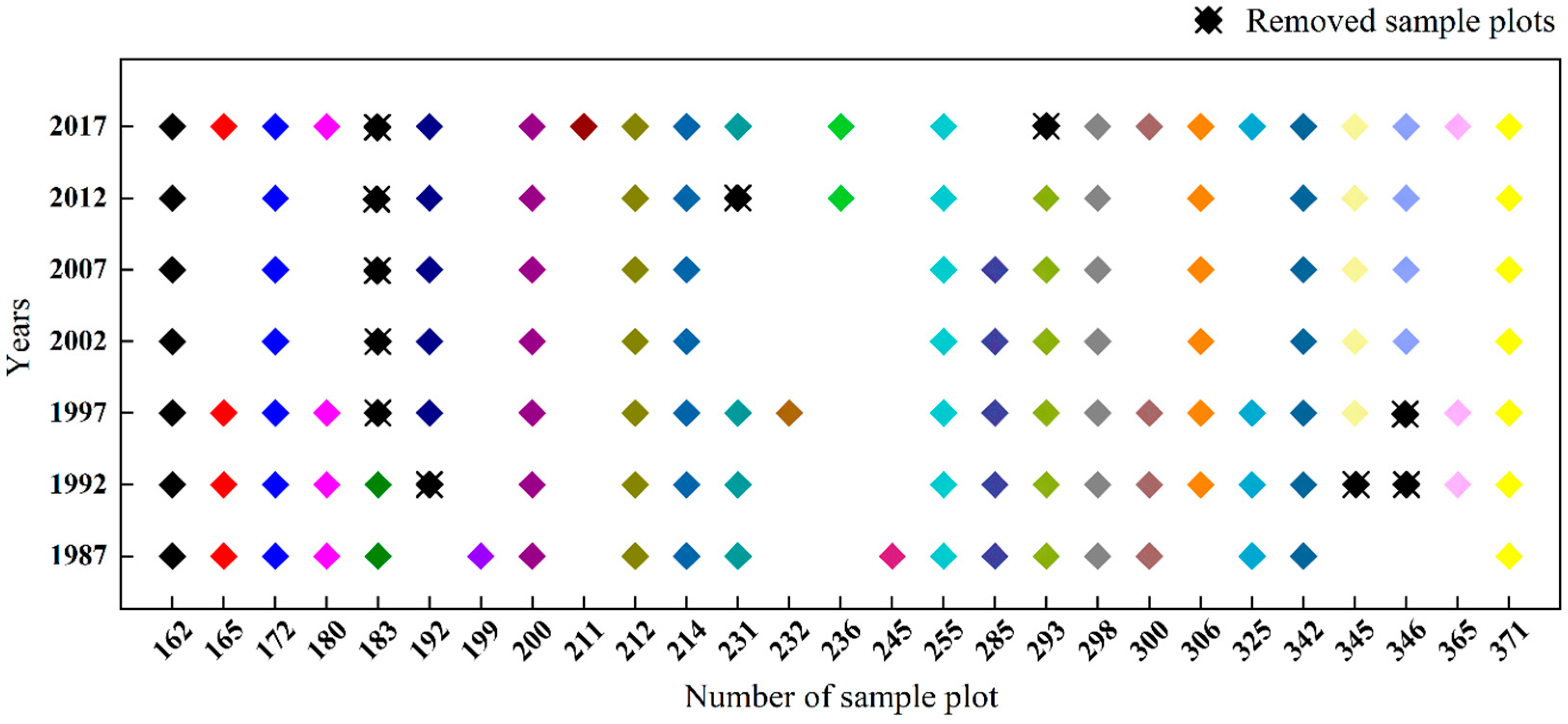


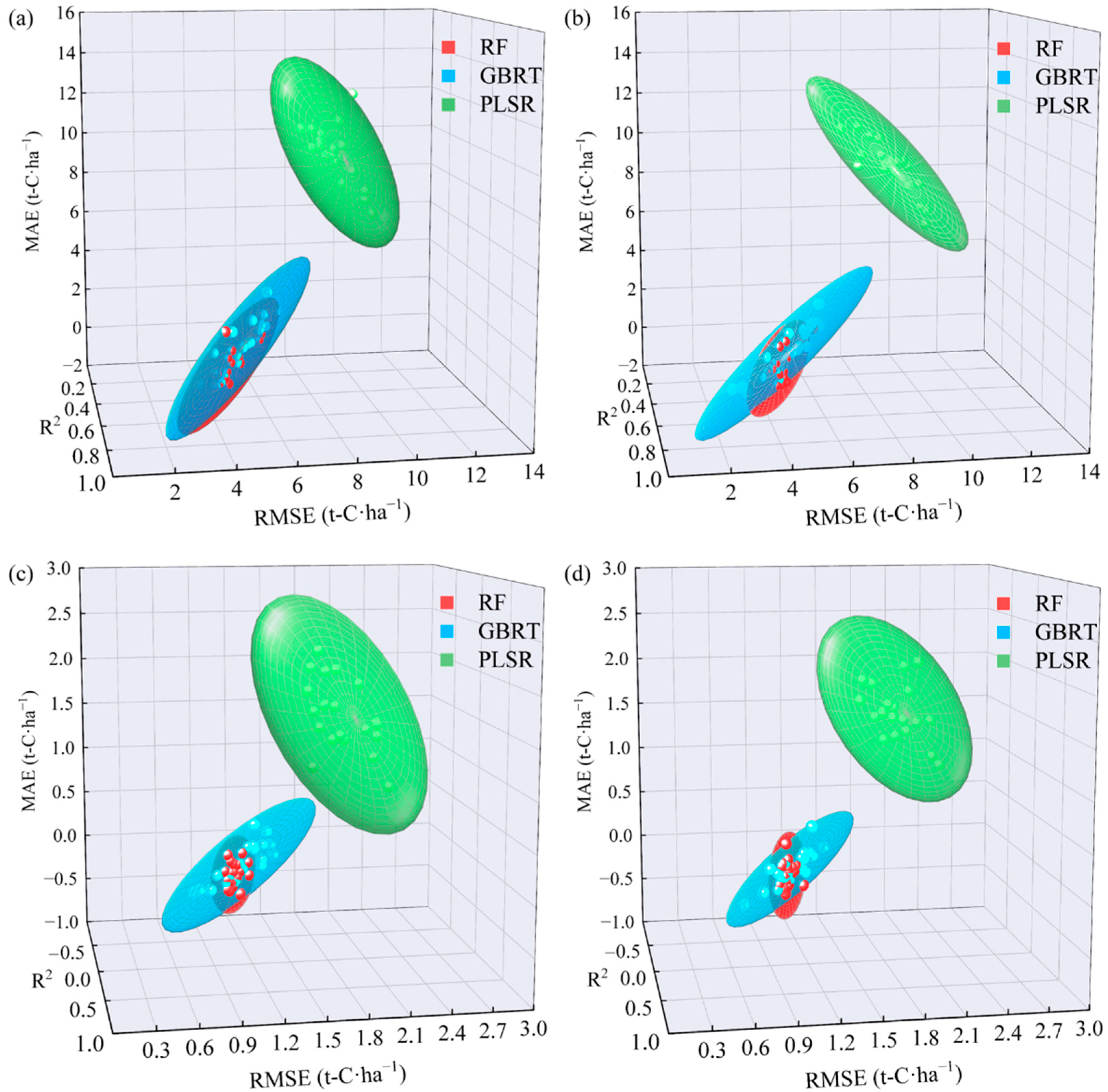

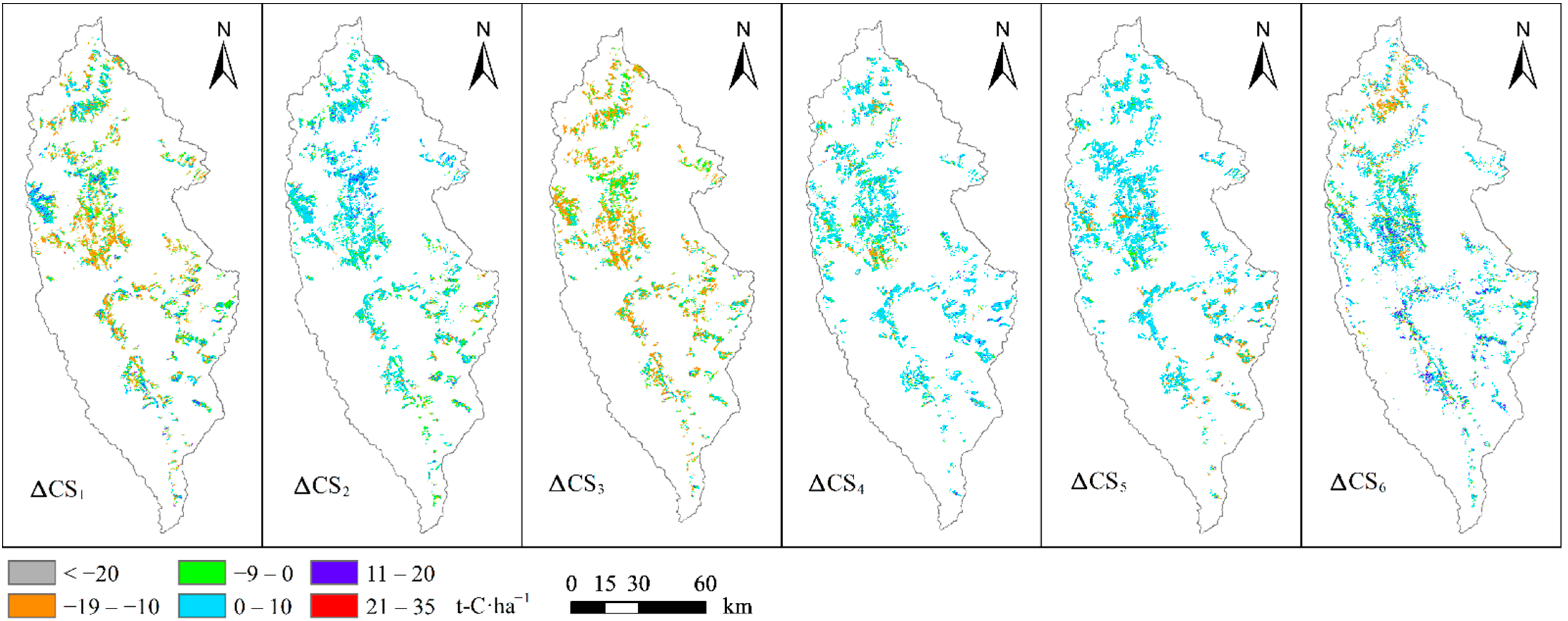
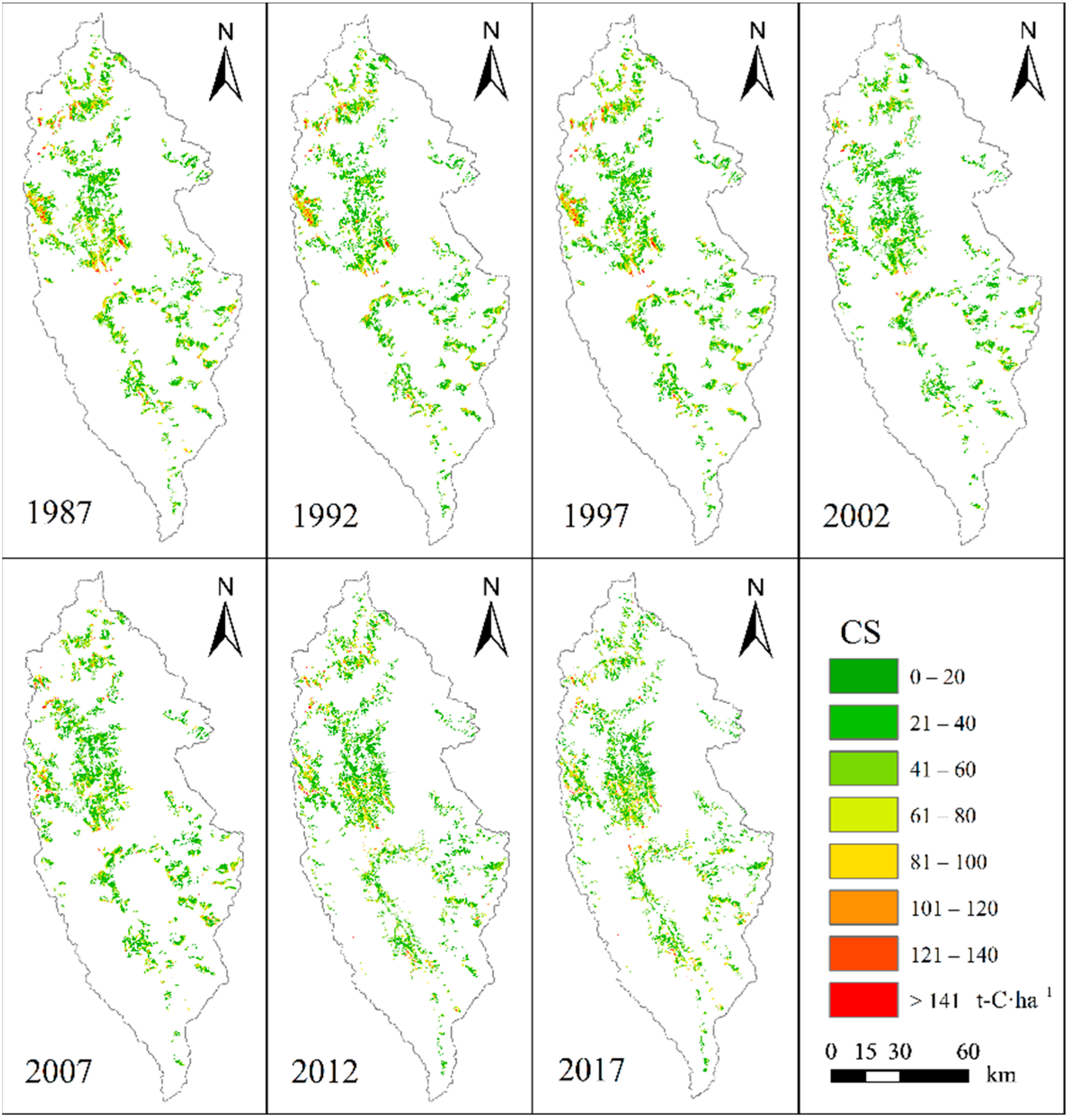
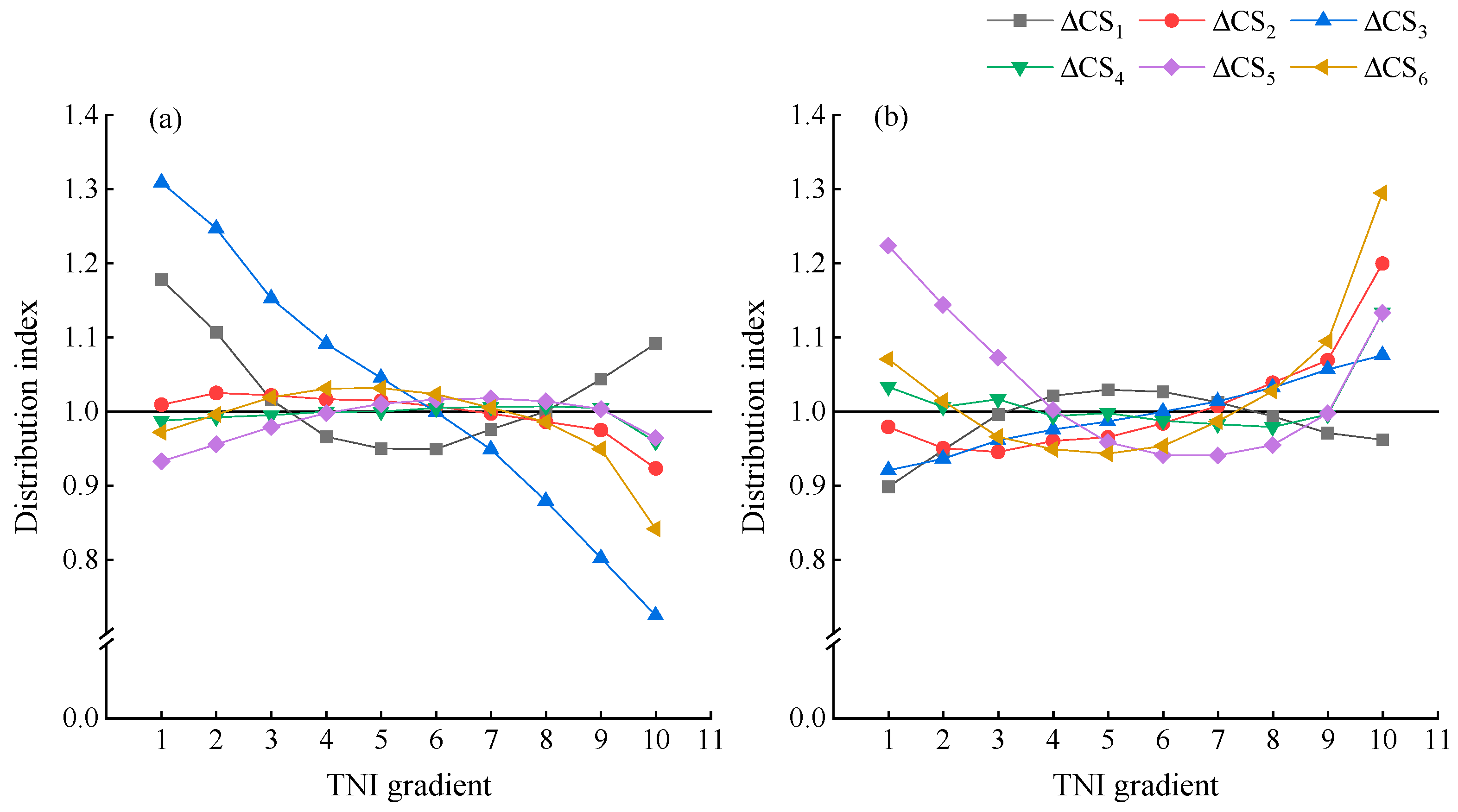
| Year | Landsat/Sensor | Path/Row | Image Acquisition Date |
|---|---|---|---|
| 1987 | 5/TM | 132/040 | 30 December 1987 |
| 5/TM | 132/041 | 30 December 1987 | |
| 5/TM | 131/041 | 23 December 1987 | |
| 1992 | 5/TM | 132/041 | 7 November 1991 |
| 5/TM | 132/040 | 7 November 1991 | |
| 5/TM | 131/041 | 16 November 1991 | |
| 1997 | 5/TM | 132/041 | 7 November 1997 |
| 5/TM | 132/040 | 6 October 1997 | |
| 5/TM | 131/041 | 16 November 1997 | |
| 2002 | 5/TM | 132/041 | 5 January 2002 |
| 5/TM | 132/040 | 5 January 2002 | |
| 5/TM | 131/041 | 29 October 2002 | |
| 2007 | 5/TM | 132/041 | 15 October 2006 |
| 5/TM | 132/040 | 3 January 2007 | |
| 5/TM | 131/041 | 1 March 2007 | |
| 2012 | 5/TM | 132/041 | 13 October 2011 |
| 5/TM | 132/040 | 14 January 2011 | |
| 5/TM | 131/041 | 7 January 2011 | |
| 2017 | 8/OLI | 132/041 | 16 December 2017 |
| 8/OLI | 132/040 | 16 December 2017 | |
| 8/OLI | 131/041 | 25 December 2017 |
| Categories | Information on Remote Sensing Characteristics | |
|---|---|---|
| Spectral features | Original bands | B1; B2; B3; B4; B5; B7 |
| Vegetation indices [37] | ; ; ; ; ; ; ; ; ; | |
| Band combination [12] | ; ; ; ; ; | |
| Image enhancement [38,39] | ; ; ; ; Principal component analysis (PCA1, PCA2, PCA3, PCA4, PCA5, PCA7); Tasseled cap transform (TCT1, TCT2, TCT3) | |
| Texture features | Grey level co-occurrence matrix [34] | Homogeneity (HO); Dissimilarity (DI); Mean (ME); Angular second moment (SM); Entropy (EN); Correlation (CC); Variance (VA); Contrast (CO) |
| Filtering of probabilistic statistics [40] | Skewness (SK) | |
| Change Type | Remote Sensing Features |
|---|---|
| 5-year interval change | , , PCA2, FVC, PCA4, R9B1EN, R17B7CO, R5B4SM |
| Annual average change | R3B3VA, R15B5VA, R17B1VA, R9B4HO, R15B5ME, DVI, PCA2, EVI, , |
| Change Type | Model | Fitting | Validation | |
|---|---|---|---|---|
| R2 | RMSE/t-C·ha−1 | MAE/t-C·ha−1 | ||
| 5-year interval change | PLSR | 0.18 | 9.61 | 9.09 |
| GBRT | 0.81 | 4.58 | 2.51 | |
| RF | 0.85 | 4.09 | 1.83 | |
| PLSRTNI | 0.18 | 9.50 | 8.36 | |
| GBRTTNI | 0.83 | 4.24 | 2.43 | |
| RFTNI | 0.87 | 3.82 | 1.78 | |
| Annual average change | PLSR | 0.23 | 1.83 | 1.64 |
| GBRT | 0.80 | 0.94 | 0.45 | |
| RF | 0.83 | 0.87 | 0.36 | |
| PLSRTNI | 0.25 | 1.82 | 1.67 | |
| GBRTTNI | 0.82 | 0.89 | 0.41 | |
| RFTNI | 0.84 | 0.86 | 0.35 | |
| Change Type | Model | Fitting | Validation |
|---|---|---|---|
| RMSE/t-C·ha−1 | MAE /t-C·ha−1 | ||
| Annual average change | PLSR | 9.16 | 8.2 |
| GBRT | 4.69 | 2.25 | |
| RF | 4.37 | 1.8 | |
| PLSRTNI | 9.075 | 8.35 | |
| GBRTTNI | 4.465 | 2.05 | |
| RFTNI | 4.295 | 1.75 |
| Year | Area of Pinus densata (ha) | Total CS (Million Tons) | Average CS (t-C·ha−1) |
|---|---|---|---|
| 1987 | 171560.28 | 5.30 | 30.91 |
| 1992 | 171560.28 | 4.24 | 24.69 |
| 1997 | 170589.86 | 4.77 | 27.97 |
| 2002 | 170589.86 | 3.12 | 18.30 |
| 2007 | 174179.37 | 3.99 | 22.93 |
| 2012 | 174213.12 | 4.03 | 23.12 |
| 2017 | 184815.84 | 3.80 | 20.53 |
Publisher’s Note: MDPI stays neutral with regard to jurisdictional claims in published maps and institutional affiliations. |
© 2022 by the authors. Licensee MDPI, Basel, Switzerland. This article is an open access article distributed under the terms and conditions of the Creative Commons Attribution (CC BY) license (https://creativecommons.org/licenses/by/4.0/).
Share and Cite
Liao, Y.; Zhang, J.; Bao, R.; Xu, D.; Han, D. Modelling the Dynamics of Carbon Storages for Pinus densata Using Landsat Images in Shangri-La Considering Topographic Factors. Remote Sens. 2022, 14, 6244. https://doi.org/10.3390/rs14246244
Liao Y, Zhang J, Bao R, Xu D, Han D. Modelling the Dynamics of Carbon Storages for Pinus densata Using Landsat Images in Shangri-La Considering Topographic Factors. Remote Sensing. 2022; 14(24):6244. https://doi.org/10.3390/rs14246244
Chicago/Turabian StyleLiao, Yi, Jialong Zhang, Rui Bao, Dongfan Xu, and Dongyang Han. 2022. "Modelling the Dynamics of Carbon Storages for Pinus densata Using Landsat Images in Shangri-La Considering Topographic Factors" Remote Sensing 14, no. 24: 6244. https://doi.org/10.3390/rs14246244
APA StyleLiao, Y., Zhang, J., Bao, R., Xu, D., & Han, D. (2022). Modelling the Dynamics of Carbon Storages for Pinus densata Using Landsat Images in Shangri-La Considering Topographic Factors. Remote Sensing, 14(24), 6244. https://doi.org/10.3390/rs14246244






